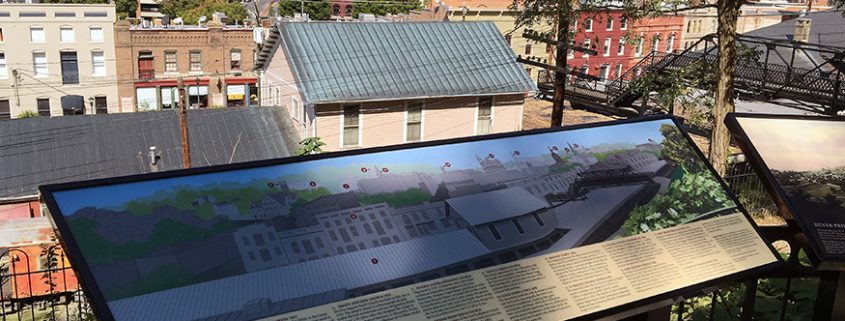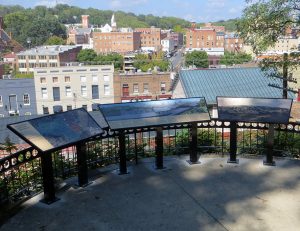
The Sears Hill Bridge dates from circa 1905 when the present train station, designed by noted local architect T. J. Collins, was erected. The rare iron truss pedestrian bridge is a contributing structure in the Wharf Historic District and is listed on the Virginia Landmarks Register and the National Register of Historic Places. The bridge connects the Sears Hill neighborhood and park, located on the steep hill south of the tracks, to downtown Staunton, providing access for over 100 years to its residents. It is an important visual element of the Wharf District’s historic landscape, and has become a popular vantage point in recent years for tourists overlooking Staunton’s historic districts. To preserve the badly deteriorating Bridge, a volunteer group, Friends of the Sears Hill Bridge Committee, chaired by Bill Frazier, rallied community support to raise over $200,000 and coordinate the rehabilitation of this historic structure and return it to public use in 2012.
To complement the installation of the rehabilitated bridge, the Committee coordinated the design and installation of these interpretive signs with Frazier Associates. The signs convey the history of train station and bridge, and recognize the community effort to preserve this important feature of the Wharf Historic District.
New Overlook Signs Installed

New overlook signs take in the view of downtown.
Fast-forward to 2016, with the restoration of the Sears Hill Bridge and access improved to the Sears Hill Neighborhood and Woodrow Park across the bridge, the City of Staunton commissioned the design and installation of an overlook area and additional interpretative signs. Frazier Associates designed the overlook and signs, as well as developing graphics and text for the signs. Historic Staunton Foundation provided content information, with editorial assistance provided by Nancy Sorrells and Katherine Brown.
The three new signs at the overlook provide a map of Staunton’s five downtown historic districts, a key with descriptive information on particular landmark buildings, and a comparative historic 1856 lithographic print by German artist, Edward Beyer of the same view of downtown.
In addition, a new sign was designed and installed to provide information about the development of the Sears Hill Neighborhood and Woodrow Park, as well as Dr. Barnas Sears for whom the hilltop neighborhood is named. Sears moved to a house adjacent to the park area in 1867, and administered an educational fund to establish free public schools throughout the South after the Civil War.
The new signs provide both historical background and orientation to residents and visitors who transverse the Bridge to take in the panoramic views of downtown Staunton. The signs were made possible by funds raised by the Friends of the Sears Hill Bridge Committee. Nearly $4,000 from the Sears Hill Bridge restoration fund was used to construct the informational signs. The funds are managed by The Community Foundation of the Central Blue Ridge. City Manager Steve Owen noted: “These signs provide visitors to the overlook with historical reference points that really complement this beautiful view of the city. They are a wonderful addition to the park and a fitting final piece to the community’s successful Sears Hill Bridge project.”
Read more about Frazier Associates’ interpretive sign projects and services at https://frazierassociates.com/services/wayfinding/parks-institutions/














